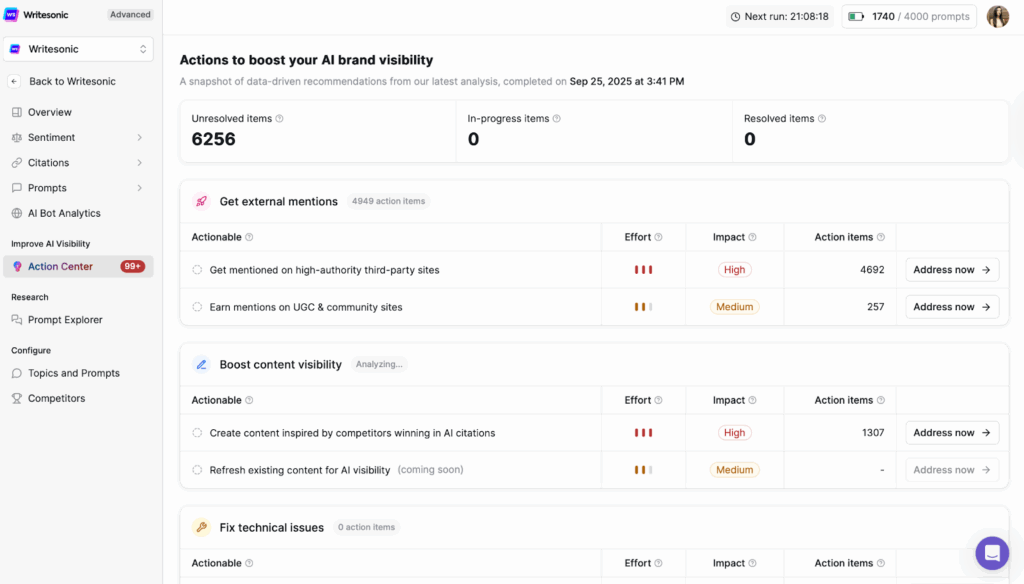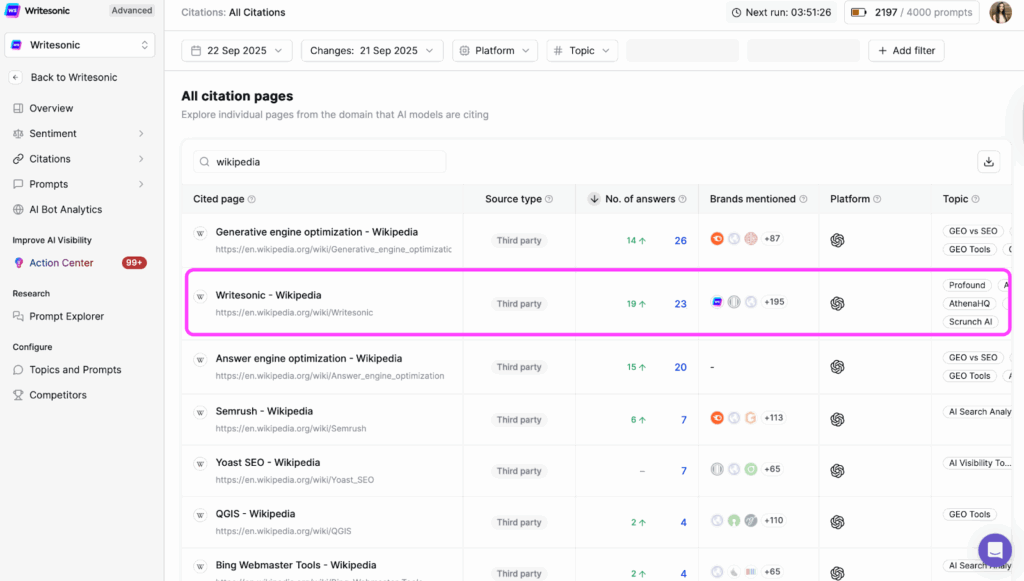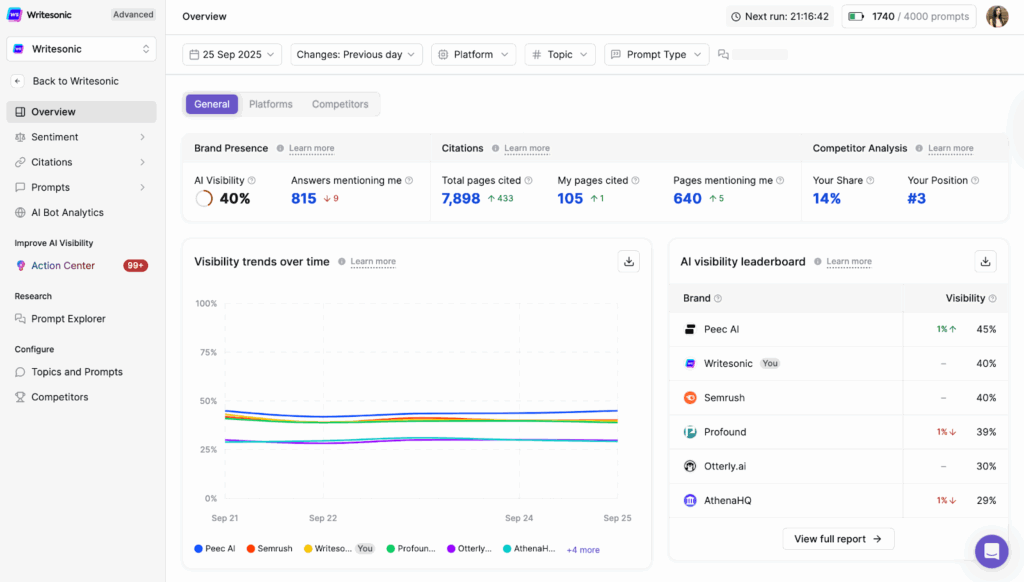Why the Traditional Marketing Funnel Doesn’t Work in the AI-Search Era


Marketers love funnels. We map them, measure them, and obsess over them.
But here’s the truth: buyers don’t move through funnels anymore; it’s sort of broken.
AI search has changed everything. Now there’s no top, middle, or bottom; instead, there’s just a single moment where the user asks AI tools like ChatGPT or Perplexity, and gets everything they need in minutes.
If your brand isn’t part of that answer, your funnel doesn’t matter.
In this post, I’ll break down how AI is changing the buyer journey, and what you need to do so your brand still shows up when the funnel disappears, plus how Writesonic can help you. Keep reading.
Key Takeaways
- The funnel is broken; buyers don’t move through TOFU → MOFU → BOFU anymore.
- AI Search collapses the journey into one query, one conversation, one answer.
- Visibility beats volume; authority signals, structured content, and topical depth matter more than churning out blogs.
- Writesonic can help you track where you show up in AI answers, spot competitor gaps, and optimize for visibility.
- Stop managing funnels. Start owning AI-generated answers.
How the Funnel Is Broken
What used to take weeks of awareness campaigns, blog posts, remarketing ads, comparison pages, and a lot more is now collapsing into one AI-powered conversation.
A buyer no longer searches “best generative engine optimization tools,” clicks 10 websites, reads 5 reviews, and then finally checks pricing.
Instead, they ask: “What’s the best generative engine optimization tool for my startup?”
And in seconds, they get features, pricing, comparisons, and even a recommendation, without ever touching your funnel. Then, of course, a couple of follow-up questions and answers till the user gets every detail.
The result? Instead of 15-30 days and 20+ touchpoints, buying journeys now take 5 minutes and 1 conversation.
This is why the traditional TOFU-MOFU-BOFU model doesn’t work in the AI-search era.
The Traditional Funnel vs. The AI-Search Funnel
For years, the funnel looked like this:
A buyer searches for “best generative engine optimization tools.”
They click 10+ websites, skim blog posts, and walk away with a basic overview.
The goal? Capture attention and drive them into your ecosystem.
Now they’re comparing options. They read case studies, scroll review sites like G2, and download whitepapers.
Nurture campaigns and remarketing ads keep your brand top-of-mind.
Finally, they search “Peec AI vs Profound pricing”.
They visit pricing pages, book demos, and talk to sales before deciding.
This whole journey takes 15-30 days and 20+ touchpoints. The funnel is long, predictable, and heavily content-driven.
Now let’s move to how the funnel looks like in AI search.
With a single query like “What are the best generative engine optimization tools for startup?” the buyer gets:
- A shortlist of tools (TOFU)
- Feature and pricing breakdowns (MOFU)
- A personalized recommendation (BOFU)
Then, a few follow-up questions and answers till the user is satisfied with the answer.
No 10 blog posts or weeks of nurturing. Just one 5-minute conversation with personalized recommendations.
Simply, AI doesn’t guide buyers through the funnel; it flattens it. As a marketer, your job is to make sure your brand is present in the AI-generated answer that replaces the funnel altogether.
Why the Funnel Collapsed
The funnel snapped because AI changed how people search, trust, and decide.
1. Instant answers replace browsing
Buyers don’t click through 10 sites anymore. One AI query gives them awareness, comparison, and recommendations in seconds.
2. Trust shifted from volume to authority
In the old funnel, more content meant more influence. Now, AI models prioritize credible, well-cited sources over content libraries.
3. Intent is richer from the start
Instead of vague queries like “Scrunch AI alternatives”, buyers now ask AI-specific, context-packed questions: “Best Scrunch AI alternatives with free trial.” That collapses multiple funnel stages into one step.
4. Discovery and decision merge
AI doesn’t separate research from choice. It delivers both at once: shortlist, features, pricing, and a recommendation, flattening TOFU, MOFU, and BOFU.
With AI, discovery and selection co-occur in the same answer. The user sees the shortlist, compares features/pricing, and often makes a decision, all in one interaction.
What the AI-Search Funnel Looks Like
AI search is changing the game, and the traditional funnel is collapsing. Here’s how the shift looks:
1. Instant synthesis
A single query can deliver what used to take multiple stages: a list, features, pros/cons, and pricing.
2. Invisible consideration
Users never see MOFU content on your site; AI reads it, digests it, and then gives the summary.
3. Decision within discovery
Buying decisions happen inside the AI answer. You’re competing to be within the answer, not just after it.
4. Feedback loops over linear flow
After the “purchase,” AI might recommend upgrades, compatible products, or complementary solutions, looping users back into discovery.
This is not just a funnel shift; it’s a behavioral shift. The path is less yours to map, and more about which content gets surfaced inside AI answers.
What Marketers Must Do Instead
Since the funnel has collapsed, you can’t keep feeding it with TOFU blogs, MOFU case studies, and BOFU landing pages alone and expect the same return.
Instead, you need a strategy built for AI-first discovery. Here’s what works today:
1. Focus on GEO + SEO
SEO remains the foundation, but just ranking higher on SERPs isn’t enough if AI answers don’t mention you. Focus on Generative Engine Optimization (GEO) to ensure your brand is cited inside AI-generated answers.
With Writesonic, you can track where your brand is mentioned or cited across AI engines like Google AI Overviews, ChatGPT, Perplexity, and others. Use that insight to adjust content (via Action Center) so you actually show up in AI search, not just rank on Google.

Also read: How to integrate GEO with SEO.
2. Strengthen Trust Signals
LLMs pull from sources they trust. Mostly they favor: Wikipedia, news outlets, analyst reports, review sites. So, it’s better to invest in:
- Digital PR campaigns that land coverage in reputable outlets.
- Building and maintaining a credible Wikipedia page.
- Customer reviews on G2, Capterra, or Trustpilot.
Here’s an example:

The more authoritative your references, the more likely AI is to cite you.
Also read: Top AI search ranking factors.
3. Structure Content for Machines
The key to improving visibility in this AI era is: write for humans, but format for AI.
AI doesn’t parse messy walls of text well. Format your pages so they’re easy to extract:
- FAQs with a direct Q&A format.
- Lists and tables for features, pricing, comparisons.
- Concise “in summary” takeaways at the end of sections.
Check out this blog on how LLMs interpret content for more details.
4. Track, Optimize, and Improve Your AI Visibility Using Writesonic
Don’t guess whether AI is citing you. Use Writesonic to monitor brand mentions, competitor gaps, and citation opportunities across Google AI Overviews, ChatGPT, and Perplexity.
Here’s how Writesonic can help:
- Monitor trends like AI visibility, share of voice, and sentiment.
- Track whether your brand is cited in Google AIOs, ChatGPT, Perplexity, and more.
- Identify where you stand against competitors in AI search.
- Analyze AI conversations to understand how you are positioned.
- Find key citation sources to improve your outreach and content strategy.
- Get instant optimization suggestions to fill content gaps.
- Customize tracking (topics, competitors, and prompts) as per your needs.

5. Bridge the Gap Between AI & Real Business Outcomes
Visibility inside AI is only meaningful if it drives results.
Writesonic’s AI Traffic Analytics helps you see which AI crawler visits your pages, which content AI values, and how that ties to conversions.
This lets you test whether being cited in AI answers actually moves the needle.
The shift is clear: stop thinking about guiding buyers through a funnel. Start thinking about showing up in the answer.
See Writesonic in action: Book a demo!
The Funnel is Dead. Here’s What’s Next.
The funnel didn’t just get shorter; it sort of disappeared. Today, buyers don’t move through stages; they go straight to the answer.
That means your job as a marketer isn’t to “nurture the funnel” anymore; it’s to make sure your brand shows up inside the AI-generated response when the question is asked.
With Writesonic, you can track where your brand is cited, spot the gaps, and measure whether you’re winning visibility in Google AI Overviews, ChatGPT, and Perplexity.
Stop feeding the funnel, start owning the AI answer.
To see Writesonic in action, get in touch with our team.
FAQs
1. Why doesn’t the traditional funnel work with AI search?
Because AI platforms collapse the funnel. Instead of moving step by step from awareness → consideration → decision, users get a direct, synthesized answer. That shortens discovery and decision cycles, leaving fewer touchpoints for marketers.
2. How does AI search change customer behavior?
People are asking AIs for product recommendations the same way they used to Google or ask friends. That means fewer site visits, fewer ad clicks, and more decisions happening inside AI answers; often before they reach your website.
3. What should marketers do differently?
Shift from optimizing for a linear funnel to optimizing for visibility inside AI-generated answers. That means focusing on authority sources (Wikipedia, news, reviews, communities) and using tools like Writesonic to track brand presence in AI engines.
4. Does this mean SEO is dead?
Not at all. SEO is still the foundation for visibility, but it’s no longer the full story. AI engines pull from multiple indices, so you need Generative Engine Optimization (GEO) to extend SEO into the AI-search era.










